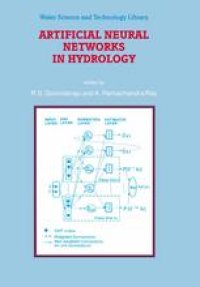
Ebook: Artificial Neural Networks in Hydrology
- Tags: Hydrogeology, Statistical Physics Dynamical Systems and Complexity, Theory of Computation
- Series: Water Science and Technology Library 36
- Year: 2000
- Publisher: Springer Netherlands
- Edition: 1
- Language: English
- pdf
R. S. GOVINDARAJU and ARAMACHANDRA RAO School of Civil Engineering Purdue University West Lafayette, IN. , USA Background and Motivation The basic notion of artificial neural networks (ANNs), as we understand them today, was perhaps first formalized by McCulloch and Pitts (1943) in their model of an artificial neuron. Research in this field remained somewhat dormant in the early years, perhaps because of the limited capabilities of this method and because there was no clear indication of its potential uses. However, interest in this area picked up momentum in a dramatic fashion with the works of Hopfield (1982) and Rumelhart et al. (1986). Not only did these studies place artificial neural networks on a firmer mathematical footing, but also opened the dOOf to a host of potential applications for this computational tool. Consequently, neural network computing has progressed rapidly along all fronts: theoretical development of different learning algorithms, computing capabilities, and applications to diverse areas from neurophysiology to the stock market. . Initial studies on artificial neural networks were prompted by adesire to have computers mimic human learning. As a result, the jargon associated with the technical literature on this subject is replete with expressions such as excitation and inhibition of neurons, strength of synaptic connections, learning rates, training, and network experience. ANNs have also been referred to as neurocomputers by people who want to preserve this analogy.
The past decade has witnessed a flurry of hydrologic research activity related to artificial neural networks (ANNs). This volume is a compilation of chapters that have been contributed by researchers from several countries, and represents a wide spectrum of ANN applications in hydrology. Future potential of ANN applications has been identified at appropriate places. Readers of the book will find chapters dealing with preliminary aspects as well as advanced features of ANNs. With a unique focus towards hydrologic applications, this book will serve as a valuable reference for graduate students, research workers, and professionals interested in learning more about this computational tool. The goal of this book is to help ANNs find greater acceptability among researchers and practising hydrologists alike.
The past decade has witnessed a flurry of hydrologic research activity related to artificial neural networks (ANNs). This volume is a compilation of chapters that have been contributed by researchers from several countries, and represents a wide spectrum of ANN applications in hydrology. Future potential of ANN applications has been identified at appropriate places. Readers of the book will find chapters dealing with preliminary aspects as well as advanced features of ANNs. With a unique focus towards hydrologic applications, this book will serve as a valuable reference for graduate students, research workers, and professionals interested in learning more about this computational tool. The goal of this book is to help ANNs find greater acceptability among researchers and practising hydrologists alike.
Content:
Front Matter....Pages i-xvi
Introduction....Pages 1-5
Effective and Efficient Modeling for Streamflow Forecasting....Pages 7-22
Streamflow Forecasting Based on Artificial Neural Networks....Pages 23-51
Real Time Forecasting Using Neural Networks....Pages 53-71
Modular Neural Networks for Watershed Runoff....Pages 73-91
Radial-Basis Function Networks....Pages 93-109
Artificial Neural Networks in Subsurface Characterization....Pages 111-134
Optimal Groundwater Remediation Using Artificial Neural Networks....Pages 135-152
Adaptive Neural Networks in Regulation of River Flows....Pages 153-177
Identification of Pollution Sources Via Neural Networks....Pages 179-197
Spatial Organization and Characterization of Soil Physical Properties Using Self-Organizing Maps....Pages 199-207
Rainfall Estimation from Satellite Imagery....Pages 209-234
Streamflow Data Infilling Techniques Based on Concepts of Groups and Neural Networks....Pages 235-258
Spatial Analysis of Hydrologic and Environmental Data Based on Artificial Neural Networks....Pages 259-286
Application of Artificial Neural Networks to Forecasting of Surface Water Quality Variables: Issues, Applications and Challenges....Pages 287-309
Long Range Precipitation Prediction in California: A Look Inside the “Black Box” of a Trained Network....Pages 311-329
Back Matter....Pages 331-332
The past decade has witnessed a flurry of hydrologic research activity related to artificial neural networks (ANNs). This volume is a compilation of chapters that have been contributed by researchers from several countries, and represents a wide spectrum of ANN applications in hydrology. Future potential of ANN applications has been identified at appropriate places. Readers of the book will find chapters dealing with preliminary aspects as well as advanced features of ANNs. With a unique focus towards hydrologic applications, this book will serve as a valuable reference for graduate students, research workers, and professionals interested in learning more about this computational tool. The goal of this book is to help ANNs find greater acceptability among researchers and practising hydrologists alike.
Content:
Front Matter....Pages i-xvi
Introduction....Pages 1-5
Effective and Efficient Modeling for Streamflow Forecasting....Pages 7-22
Streamflow Forecasting Based on Artificial Neural Networks....Pages 23-51
Real Time Forecasting Using Neural Networks....Pages 53-71
Modular Neural Networks for Watershed Runoff....Pages 73-91
Radial-Basis Function Networks....Pages 93-109
Artificial Neural Networks in Subsurface Characterization....Pages 111-134
Optimal Groundwater Remediation Using Artificial Neural Networks....Pages 135-152
Adaptive Neural Networks in Regulation of River Flows....Pages 153-177
Identification of Pollution Sources Via Neural Networks....Pages 179-197
Spatial Organization and Characterization of Soil Physical Properties Using Self-Organizing Maps....Pages 199-207
Rainfall Estimation from Satellite Imagery....Pages 209-234
Streamflow Data Infilling Techniques Based on Concepts of Groups and Neural Networks....Pages 235-258
Spatial Analysis of Hydrologic and Environmental Data Based on Artificial Neural Networks....Pages 259-286
Application of Artificial Neural Networks to Forecasting of Surface Water Quality Variables: Issues, Applications and Challenges....Pages 287-309
Long Range Precipitation Prediction in California: A Look Inside the “Black Box” of a Trained Network....Pages 311-329
Back Matter....Pages 331-332
....